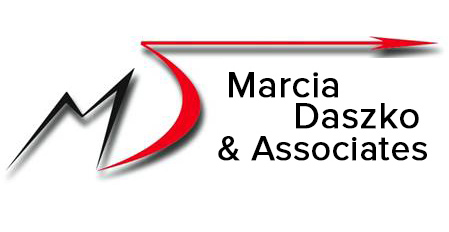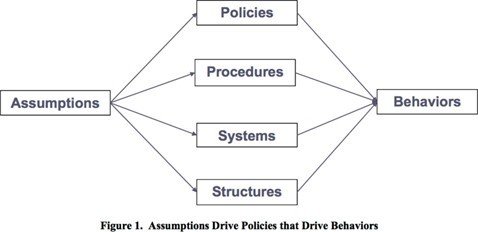Coaching. As was mentioned above, a system cannot see itself. If the knowledge to solve a problem was at hand, then it would have been employed to avoid the problem. The dilemma for managers is finding qualified outside help.
The ‘output’ of the above system is the theory and method for transformation. The SoPK provides the knowledge that leaders need to lead a transformation. It is through the lens of the system of profound knowledge that people can work on transformation; new thinking, new learning and new creating in the organization. The ‘customers’ of this process are, first, the managers and employees of the organization; then, the customers and suppliers with whom the organization does business; and then the organization’s competition.
The presence of a feedback and reflection loop represents that the process is ongoing. It is this cyclical element of the system that makes it so powerful. That is, transformation is a never-ending process of continually choosing and learning and taking action. In some ways, the end-result (i.e., the development and application of a theory of management) is not as important as the process by which the result was developed. It is the difference between a solution and an answer. The trap will always be to think that you have “arrived.”
Why Transformation Fails
The aim of this section is to discuss the psychology of transformation and the frequent barriers to successful transformation. Transformation fails when there is a lack of leadership with profound knowledge, vision and courage. Transformation demands all of these elements. The personal journey of transformation can be both frightening and exhilarating. It demands energy and a deep commitment to learning and significant change.
Consider the following guide for successful transformation.
Success = A x V x M x L x I (6)
where
A= Awakening,
V= Vision,
M= Method,
L= Learning, and
I = Integration.
While each of the elements is interdependent, the elements occur sequentially with feedback loops. Awakening gives rise to envisioning the future; which in turn, provides a sense of vision, and so on.
Awakening. We have discussed the concept of awakening. The awakening will be motivated by profound dissatisfaction with the current state and/or the vision of the future state should the current approach to management and leadership remain. If you are comfortable and perceive no threats then there will be little intrinsic motivation to do things differently. The dissatisfaction has to be substantial.
The most challenging scenario is to be dissatisfied when, according to conventional measures (e.g., revenues and profits), the organization is successful. This is what makes the story of Marshall Industries (Free, Perfect, and Now, Rodin [2000]) amazing. Marshall Industries was very successful. But they chose to transform and to create a new future.
Only when the awakening becomes great enough, will you be motivated to do things differently. Significant dissatisfaction coupled with envisioning a compelling vision places the individual and the organization at the doorways of change and transformation. With an awakening, the choice will be transformation. Without an awakening, the choice will be change. The best time for an organization to transform is when they are healthy; however, many approach transformation when they are in a crisis situation and don’t know what to do.
The challenge with each of these components is communication to others. One person’s dissatisfaction has to be effectively communicated to others. The consequences of maintaining the status quo have to be compelling. The communication of dissatisfaction can have two faces. On one hand, the dissatisfaction can be presented and developed in others by articulation of vision (see below). That is, by having a sense for what the future looks like, individuals realize that their world could be better and they are dissatisfied with the thought of settling for the current state. On the other hand, dissatisfaction can be presented that creates fear in others. That is, presenting the consequences of the status quo that demonstrate that the status quo is suicidal; that the current path leads to extinction (that we have been rearranging the deck chairs on the Titanic).
Because not everyone will accept transformation, the leaders need to prepare people for the journey. Leaders need to acknowledge the fears that transforming an organization will create. People fear losing their jobs, making mistakes, speaking up. There will also be strong resistance to change. Transformation invites criticism. When the organization needs to do things differently, it is often implied that it is because you have been doing things wrong!
Because it is common, unfortunately, to have a “management theory” of criticism and blaming, this response to transformation is not unreasonable. Common practices have become synonymous with best practices, however, and enterprises are dedicated with best intentions and efforts and hard work. Unfortunately, too many leaders are not taking the time to think about what they are doing and the impact of their actions and the “best practices” they are imposing. In their aggression for lean, six-sigma, accountability, and other recent fads, they are creating stress, internal competition, sub-optimized systems, and loss. Leaders begin to lose control of their organization and do not understand why. Therein lies the need for transformation, a new view of seeing the world and business.
Vision, Vision is an ever-evolving picture of the future. At the beginning of the transformation process, that vision can include an exciting sense of the “better way”. It can also include a terrifying view of what can happen if things remain unaltered. Once on the transformation path, it is an ever-evolving flood of opportunities. The vision must be collaborative because one person will not be able to articulate everything. The journey will be difficult. Fears will abound: the fear of change, of loss, of the unknown, of making mistakes, of failure, of “not getting it,” etc. On the other hand, as others awaken and join the transformation process, barriers and “silos’ will break down, collaboration and synergy will be incredible; the creativity and innovation will be staggering.
Method. The method for transformation is the system of profound knowledge which include the specific thinking Deming gave us: fourteen points, the elimination of the deadly diseases, and the PDSA cycles. It would be easy to think of “method” or “next steps” in the traditional ‘strategic plan’ mindset. Unfortunately, the path of transformation is not predictable; it is iterative and predicated on learning. In a transformation journey, the next steps will be to think about thinking (see Six Thinking Hats, DeBono [1999]). It requires thinking through and about feelings, data, process, creativity, caution and optimism. The aim of the “journey” of transformation is to create the journey using the system of profound knowledge as the lens.
Learning. We have discussed learning extensively, too. Learning and using the system of profound knowledge as a lens through which beliefs and paradigms, systems and processes, language and tools are developed and evaluated is the core of creating transformation.
Integration. Transformation is not required of the entire organization instantaneously and simultaneously. As will be discussed in the next section, individual psychological resistance to transformation will be present. However, because the organization is a system, eventually transformation will have to be integrated throughout. The feedback and reflection loop is critical, and it represents that transformation is a progressive and iterative process.
Conclusion
We must transform, not merely change or improve if we are to create a viable future. It will take leadership with profound knowledge and courage to have the stamina and commitment that transformation requires. Transformation is not easy, but it is critical to the health of our families and global society. Transformation is not for the other person to do, but for every individual to take personal responsibility to help create new futures, to ask questions, to take risks, and to make a difference.
Marcia Daszko | www.mdaszko.com | 408-398-7220 | md@mdaszko.com
Sheila Sheinberg | www.sheilasheinerg.com | 360-876-2399
References
Ackoff, Russell. Creating the Corporate Future, John Wiley & Sons, Inc., NY: 1981.
Adler, Alfred. Understanding Human Nature, Hazelden, Center City, MN: 1998.
Argyris, Chris. Overcoming Organizational Defenses, Allyn and Bacon, Boston: 1990.
Cheaney, Lee. Contributed the first introduction to the BOHICA curve. 1992.
Covey, Stephen R., The Seven Habits of Highly Effective People, Simon and Schuster, New York: 1989.
Daszko, M., Pivot Disrupt Transform, Diversion Books, New York: 2018.
De Bono, E., Six Thinking Hats, Little, Brown, and Co., 1999.
Deming, W. E., The New Economics, MIT Press, Cambridge: 1993.
Deming, W. E., Out of the Crisis, MIT Press, Cambridge: 1986.
Gharajedaghi, Jamshid. Systems Thinking, Butterworth – Heinemann, Boston: 1999.
Heifetz, Ronald A. and Linsky, Marty, Leadership on the Line, Harvard Business School Press, Boston: 2002.
Joiner, Brian L., Fourth Generation Management, McGraw Hill, New York: 1994.
Keirsey, David and Bates, Marilyn. Please Understand Me, Prometheus Nemesis, Del Mar, CA: 1984.
Miller, Lawrence M., Barbarians to Bureaucrats, Potter, New York: 1989.
Rodin, Robert. Free, Perfect, and Now, Simon and Schuster, New York: 1999.
Rodin, Robert and Backaitis, Nida. Beyond The Sounds Of Silence (unpublished monograph): 1995.
Ruiz, Don Miguel. The Four Agreements, Amber-Allen Publishing, San Rafael, CA: 1997.
Scholtes, Peter R., The Leader’s Handbook, McGraw Hill, New York: 1998.
Senge, Peter M., The Fifth Discipline. Doubleday, New York: 1990.
Senge, Peter M., The Dance of Change, Doubleday, New York: 1999.






















